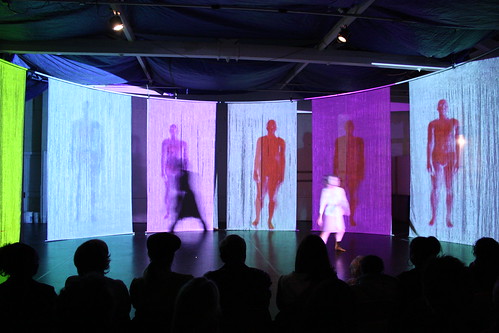When students begin to take ownership of creativity, they change. Our students began finding ways to spend more time in the studio. They talked about how they were creative, what they struggled with. Girls talked about bodies. Thin. Tall. Big. Fat. Amanda took such great care of them through this. She saw each dancer–always called them “dancers” never kids or students–as an individual filled with beauty and movement. They came to see that as well.
They started to concern themselves with their performances. So they started concerning themselves with each other. They took care of each other and developed new responsibilities. New senses of self.
Their first performance as part of the company was scheduled for the week of the school’s Spring Concert. That meant that the stage was up. In the big venue. With lots of seats–and lots of people. Having performed on that stage many times I can tell you that it is a big space, it will swallow you whole. It demands a certain performer. Particular confidence. Bravado.
When the students took the stage, they were present. They took command. Tunnel vision. They had that audience.

The piece, according to the MiRo process, was a parallel process that the company used as they developed work. Students explored ideas, researched, completed movement exercise and exploration–the same ones that the company members completed. They wrote notes on the chalkboards of the studio. They wore their socks floppy. To say it was parallel process is misleading. They were members of the company and they prepared as such.
The work of the students was pervasive. It seeped into the work of the company, and why wouldn’t it? When Pitch Black had its premiere at Altria with outrageous score by JakobTV for saxophone quartet and boombox, the students were in the audience and, if you looked, they were on stage as well. On panels. On stage. On bodies. Projected, being thrown, from 100 feet away at the rear of the room. Our front row special guests–on a late night in Manhattan after hustling down the glowing streets of Times Square–watching MiRo perform while video projections bent, stretched, waved and laughed–the same students looking back at them from panels on stage.
They were there. We were there. It was moving. It was tragic.
Why had it taken so long? Aside from that, it was joyous. We were alive.
Ms. Amanda, Mr. Tobin? When’s the next rehearsal?
Click here to support the inspiration of students in Philadelphia
Through imitation, the teacher, group leader, or even the students perform for the class and the class in turn repeats what was played for them. Exploration allows students to seek out the musical aspects that the Orff instruments offer and explore aural / oral skills and the motions and expressions that the body is capable of. Literacy is taught by learning musical notation and becoming familiar with forms of music like rondo and ABA. Improvisation is the act of creating something, especially music, without prior preparation.